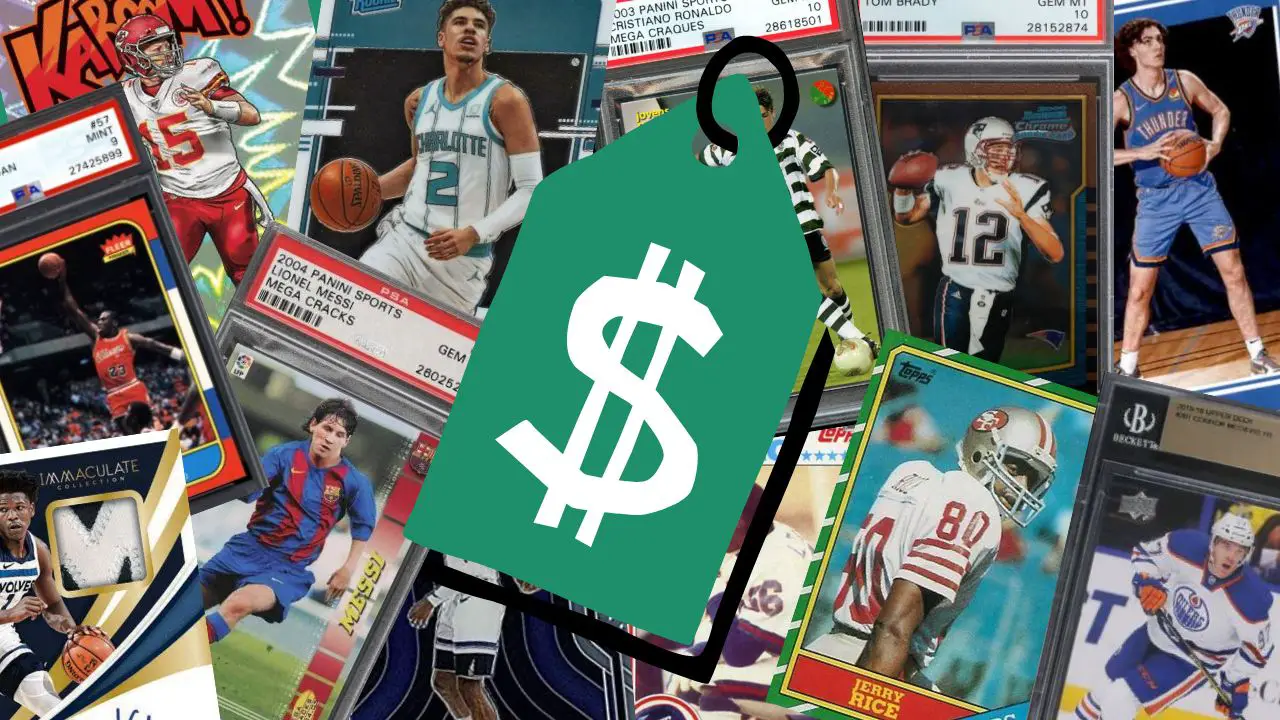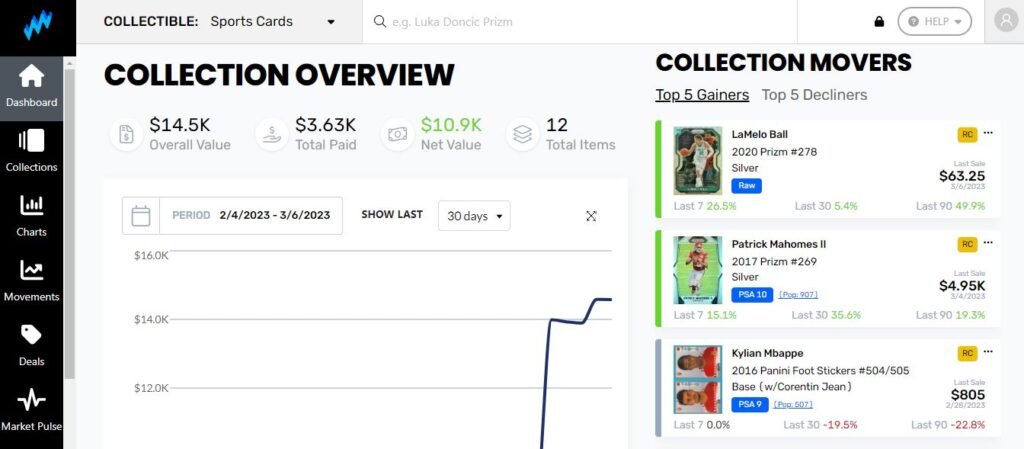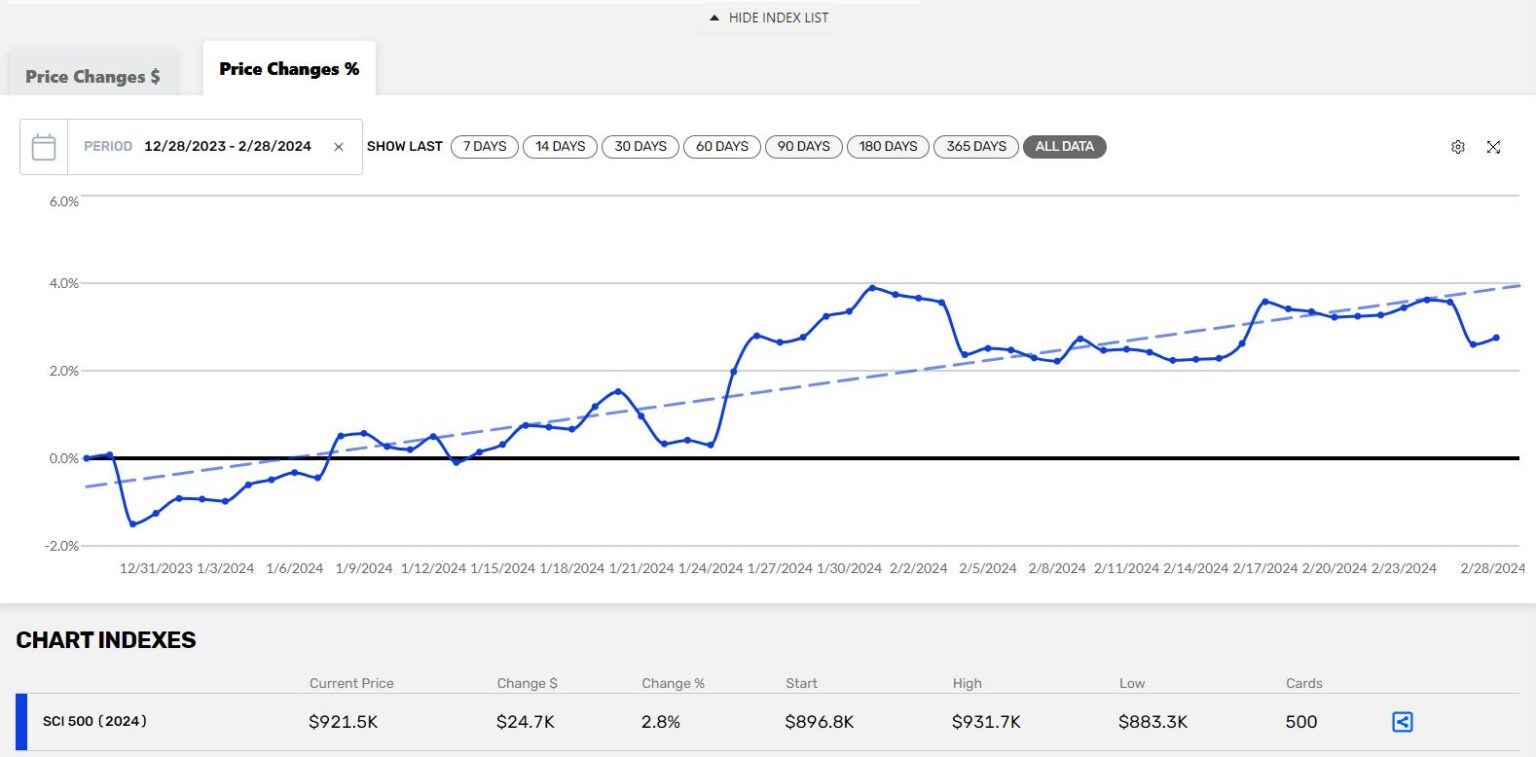
The demand and popularity of sports cards rises and dips in cycles, as we see with any asset or collectibles market, but on an individual card basis, what determines which cards are worth more, and what factors contribute to a card’s value on the secondary market?
For me, there are 7 main factors that determine the price of a sports card:
- The player that’s featured.
- The card’s rarity.
- The grade, or condition.
- The presence (or absence) of premium features, like signatures.
- The print year.
- The manufacturer/brand.
- The strength of the overall sports card market.
I’ve covered those in more detail, below.
Table of Contents
Recommended Tool:
Market Movers
The hobby’s best app to track your sports card collection and easily check the price history of cards with graphs and data, all in one place.
What Factors Affect The Value Of A Sports Card?
The Player That’s Featured On The Card
The popularity, and even playing position, of the player that’s featured on a sports card is one of the primary factors of what determines its value.
That’s because the demand for a legend of the sport will far outweigh the demand for an average player.
The hottest new rookie, with potential for greatness, will also see an increase in demand because of the hype and speculation about what they can go on to achieve.
Card manufacturers sometimes also limit the amount they’re printing for the top rookies, to try and contribute to that hype, and drive up values.
Collectors also tend to favor ‘exciting’ positions – So think Quarterback in football, or Shooter in basketball, for example.
The top players in these positions generally get more headlines and popularity, and we see the same with sports cards, generally their cards command higher values.

The Card's Rarity
Supply and demand play a big role in the value of an asset.
The rarer a sports card is, the less supply there is for collectors who want it – Scarcity creates value.
That’s why mass-produced base cards don’t often hold a great deal of value, whereas a low-numbered parallel, for example, is likely to be worth a lot more.
We saw prices of sports cards tank in the 80s/90s ‘Junk Wax Era’ because manufacturers started overproducing cards, and leagues were handing licensing to anyone who wanted in on the gold rush of sports cards at the time.
It’s a good example of when the balance of supply and demand tipped too far to one side (supply), and that had a big impact on card values.
Grading also creates another layer of rarity; Even mass-produced cards might become relatively rare in the highest grades, and that drives the value of them up.

Grade/Condition
It’s well-known that the better condition something is in, the more it’s worth, and that’s true for sports cards.
The difference in the value of a card that’s PSA 9 compared to the same card in PSA 10, for example, can be huge.
It highlights the fact that collectors value a card’s condition, and it has a big impact on its market price.
Card buyers generally consider 4 different factors, for ungraded cards, when assessing its condition:
- Corners – Look for symmetrical and well-defined corners with no peeling or damage.
- Edges – Look for straight and undamaged edges to the card.
- Centering – Look at the symmetry of the borders and centering of the design print.
- Surface – Look for any scratches or imperfections on the surface, also and color fading.
Signatures & Relics
The presence, or absence, of premium features, like signatures and relic pieces, play a role in the valuation of a card.
The sports card hobby has changed over time, and in modern times we’re used to seeing big-hitting releases of cards that include player signatures and memorabilia patches (which might be a piece of match-worn jersey, for example).
Naturally, cards with these high-appealing features are limited, and therefore drive values up because of scarcity, and also highly-desired by collectors or investors, so drive values up even higher because of demand.

Print Year
The year that a card is printed can have an effect on its value, for multiple reasons.
Firstly, cards from a player’s rookie year tend to have a higher level of collectability in the hobby, than cards from their other playing years, and we often see higher values.
This is especially true with legends and the current best players; There’s an aura and nostalgic appeal about cards from their first year, when they weren’t the name they are now, and many collectors love that.
Another reason that the print year of a card might have an effect on its value is that older cards might become harder to come by as time passes, especially in good condition, so supply drops with time, and if demand remains, then the values increase.
It’s linked back to that supply and demand balance.
Manufacturer/Brand
Certain card manufacturers and brands are more popular than others in the hobby, and therefore cards from those sets are more sought-after, and valuable.
Panini, for example, is one of the most well-known and popular sports card manufacturers; They have various different products and brands, within the sports they release cards for, that have differing levels of popularity.
So, if I’m naming the most popular Panini sets for football cards, I’m thinking Prizm, Optic and National Treasures, for example.
While there are more premium and valuable sets, these have the popularity of the mainstream releases, aimed at the masses – So, cards from those sets will generally be worth more than similar level brands like Panini Absolute football or Panini Score etc.
The Overall Sports Card Market
The status of the overall sports card market has an effect on the prices of individual cards.
Like any asset market, the sports card hobby as a whole sees peaks and troughs, and goes through cycles.
Sports cards are not an essential need, so if the overall economy is taking a hit, and collectors have less disposable income to put towards their collection, or to invest in sports cards, then generally the values will drop as the demand does.
On the flip side of that, if sports cards get a renewed level of hype and coverage, like we saw in 2020 and 2021 for example, then values can rise across the board, with lots of new investors and collectors entering the hobby.
Market Movers has a great Market Pulse tool, which includes indexes, to show the trend of the overall market; It also has sport specific indexes.
Final Thoughts
So there are the 7 main factors that contribute and determine the value of an individual sports card.
You might’ve noticed that all 7 are essentially linked to supply and demand – that’s the thing that really determines the value of an asset or collectible like sports cards.
The 7 main factors I’ve listed above are really the main drivers that affect the balance of supply and demand, and therefore ultimately the price that collectors and investors pay for any given sports card.




